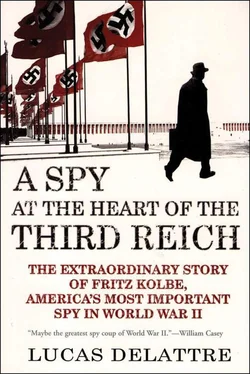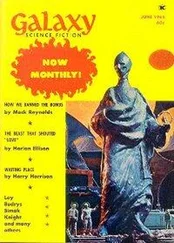While Allied bombs were raining on Berlin, a strange feeling of serenity took hold of Fritz Kolbe. He was happier and happier, and ever more relaxed, as though he were flourishing because of the inner anger that inhabited him. Taking advantage of the air raids, he spent a good deal of his time chatting with his colleagues, in the corridors of the ministry or in its underground bunker, one of the safest in the city, located under the Adlon Hotel a few steps from Wilhelmstrasse, not far from the Brandenburg Gate. With bombing becoming more frequent, the Adlon had been transformed into a kind of salon that favored encounters. It was one of the only shelters in Berlin where one did not have to fight to get in. No crush or excessive panic; these were civilized people, though of course you had to be careful to avoid indiscreet ears. “The enemy is listening to you” ( Feind hört mit! ) could be read on matchboxes of the time—an expression that had to be taken literally in all circumstances. However, it was easier to exchange confidences there than elsewhere, even if in an undertone.
Berlin, spring 1943
Thanks to his perpetual comings and goings during this time between his office, underground shelters, and the Charité hospital, Fritz Kolbe had some encounters that would soon have a decisive effect on his plans. He met up again with Karl Dumont, formerly posted to Madrid, who was now in charge of relations between the Foreign Ministry and the Wehrmacht’s weapons procurement organization. Long-standing friends, Dumont and Kolbe completely trusted each other.
A little later, probably in the spring or summer of 1943, he met Count Alfred von Waldersee at Professor Sauerbruch’s. Major Waldersee was almost the same age as Fritz (he was born in 1898). He had been posted to France and then fought in the battle of Stalingrad, from which he had had the good fortune to be evacuated because of a wound. Waldersee had close ties to the aristocratic and military circles that were the most ferociously opposed to Hitler. His friends, Fritz knew, had no hesitation in using the words “assassination attempt,” “coup d’état,” and even “revolution.”
We know almost nothing about this connection, except that Count Waldersee made the first move toward Fritz, with the obvious aim to get firsthand information from the Foreign Ministry. Waldersee seems to have been important for Fritz, and presented him in various documents written after the war as a close friend, even an accomplice. A minor official a friend to an aristocratic officer: war, like sports, breaks down many social barriers.
Since late 1942, Fritz had also been in contact with a surgeon from Alsace, Professor Adolphe Jung, whom he had met at the Charité hospital. Professor Jung was one of Professor Sauerbruch’s colleagues. He had had to leave annexed Alsace to serve in the hospitals of the Reich, which were flooded with patients and wounded soldiers and suffering from a severe shortage of qualified personnel. He lived in a small room in the Charité’s surgical clinic, just below Maria Fritsch.
Fritz made the first move toward Dr. Jung. His approach was a little provocative. “Do you have courage? Are you daring?” he said at their first meeting (probably in late 1942). Jung said nothing, afraid of falling into a trap. Then Fritz revealed something, as though to test him: “Warn your friends in France. Otto Abetz, the German ambassador to occupied France, wants to arrest Cardinal Gerlier, the archbishop of Lyon.” Just in case, Jung decided to transmit the message through his brother, the manager of a large store in Strasbourg, but he was mistrustful. Who is this Fritz Kolbe? he wondered. Jung later wrote:
Because of my functions and in the milieu to which I was transplanted I was brought into contact with the most notorious anti-Nazi elements, and I had the opportunity in particular to meet K., a fierce enemy of the regime and a secretary in the Foreign Ministry…. When I arrived in the capital of the Reich, alone in enemy country, how could I know whom I was dealing with? When an individual uttered threats against the Nazi authorities, how could I know whether he was in good faith or whether he was only an agent provocateur for the Gestapo endeavoring to discover enemies of the regime? I knew nothing about him. He was German, and he had a very visible position in the Foreign Ministry. He told me that he was not a member of the National Socialist party. And yet, I said to myself, he keeps his official post! Shouldn’t I be doubly distrustful? I observed him during the visits he made to an employee of our clinic whose fiancé he claimed to be. He told me that he had lived abroad for a long time, had learned to like and admire the English, the Americans, and the French. He loathed militarism and uniforms. He was sensible, level-headed, and cautious, although bursting with energy. Gradually we came closer together. Suddenly, after a few months, we were decided. We had to help one another, we had to work together.
Fritz was charmed by this elegant Frenchman, who also knew the United States from having studied there. Transferred by force to the interior of the Reich in March 1942, Adolphe Jung had worked first in the Lake Constance region, and then joined Ferdinand Sauerbruch’s staff in Berlin. He had arrived in Berlin in October 1942. The appointment was a stroke of luck for him, enabling him to work with a leading doctor. At the Charité hospital, he treated chiefly Professor Sauerbruch’s private clientele.
From one air raid to the next, Fritz and Adolphe Jung got to know each other better: “In the shelter where we met during Allied air attacks,” Jung wrote after the war, “we usually passed each other by without speaking. If possible we stayed in separate compartments of the shelter. But what joy shined in our eyes when Allied successes saddened the pale faces of the Nazis surrounding us. K. tightened all the muscles of his face, struck his left palm with his right fist, and constantly repeated: ‘What are they doing? What are they waiting for? Berlin has to be bombed over and over! We’ll die, so what, but let them come!’ We were agreed, K. and I, that they had to come. But can I be blamed for confessing that just thinking about it made a chill run down my spine?”
When she heard Fritz use this kind of language, his lover Maria couldn’t stand it. “Now keep quiet, keep quiet. Are you mad?” she asked. Turning to Adolphe Jung, she exclaimed, “He’s mad, isn’t he? He doesn’t know what he’s saying! He laughs stupidly like that, to himself, when the sirens wail and warn us of another thousand bombers from the RAF or the U.S. Air Force, what is that all about?” “K. was not mad,” writes Jung, “but very intelligent, very aware of all the dangers. Perhaps he was sometimes a little too excitable, but that was his temperament. He was well served by a vigorous imagination which enabled him to find in a flash the right solution or the right reply in the most difficult situations. His hatred of Nazism was real. For the Germans he had only disdain. ‘They’ll die,’ he said, ‘they’ll get what they deserve.’”
In the spring of 1943, Fritz met an exceptional woman who was to be of great help in his plans. A little cold at first sight, slightly older than Fritz (she was approaching fifty), this woman looked like a rather austere old maid, which did not keep her from being refined and elegant. Her name was Gertrud von Heimerdinger, and she had a decision-making position in the diplomatic mail service (office 138, Wilhelmstrasse 74–76). She had the power to recommend one diplomat or another for a particular foreign post. Fritz had an intuition that she shared his opinions. He had a few very precise ulterior motives for approaching her. He had not given up his plan to go to Switzerland, and he counted on making her into an ally.
Читать дальше











